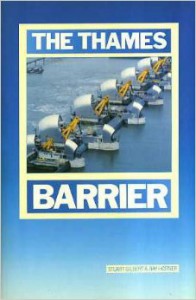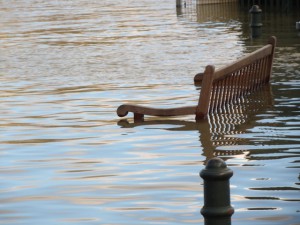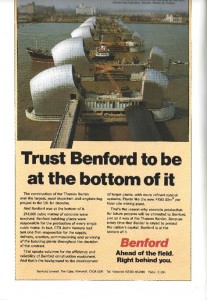Falling Down the Thames Blog 48, 11th February 2015
Keeping London’s Feet Dry
You never know quite what you might find while strolling among the shelves of a university library. I recently found a 1984 book entitled The Thames Barrier. It was written by Stuart Gilbert and Ray Horner. The book contains a wealth of information about the River Thames along which Krista and I will soon be paddling.
In last week’s blog, I explained how vulnerable London is to flooding as the result of several co-conspiring factors. The book in hand went further, describing how humans had altered the landscape over a period of several centuries resulting in London becoming increasingly vulnerable to catastrophic flooding. The creation of docklands where previously there had been marshes, channelization of the River Thames within river walls, and even the construction of the original London Bridge causing changes in the deposition of silt had all put London at risk. At a conference in 1971 authorities concluded that, relative to the land, sea levels around London were rising at a rate of 30 centimetres per century. This wasn’t good.
There are records of horrific flooding of the River Thames devastating London as far back as 1099, with further reports from 1236, 1242, 1663, 1791, 1834, 1852… well, you get the idea. A surge tide in 1953 caused water to breach flood defences along England’s east coast, flooding 160,000 acres of farmland and 200 miles of rail lines, damaging 24,000 homes, killing 11,000 cattle and 9,000 sheep, and drowning 300 people. A combination of factors meant that London itself was largely spared in 1953, but the portion of the city that would be affected by a really big flood was home to more than a million people living in 350,000 residences. Something had to be done.
For London the best solution was considered to be a barrier across the River Thames. However, as described by Gilbert and Horner: “an immense structure would have to be built on entirely new principles without the help of previous smaller examples.” The barrier would have to be engaged when the risk of flood was deemed high, but disengaged at other times to allow the continued movement of ships.
In next week’s blog I will describe the Thames Barrier, and what role in plays in the ongoing safety of Londoners.
In the meantime, I would like to share a funny side of Gilbert and Horner’s book. After 182 pages of explanatory graphs and text, the volume ends with thirty-one pages of glossy advertisements for companies that were, in some way, associated with construction of the Thames Barrier. These include Davy McKee Ltd which designed and supplied operating machinery, Sunderland Forge Limited which provided concrete formwork securing systems, Benford Limited which provided 214,000 cubic metres of concrete, Reinforcement Steel Services which supplied reinforced steel, and Alexandra Towing which towed things around. I searched online, and found that at least 80% of the firms with advertisements in the book are still in business. I will find this a bit comforting as Krista and I paddle our kayak through the Thames Barrier.
- Glen
Photo credits: The Thames Barrier by Gilbert and Horner – www.amazon.com; Mallard ducks taking advantage of a flooded yard with a trampoline – www.demotix.com; Flooded park in Henley-on-Thames – www.theguardian.com; Trust Benford – The Thames Barrier by Gilbert and Horner




